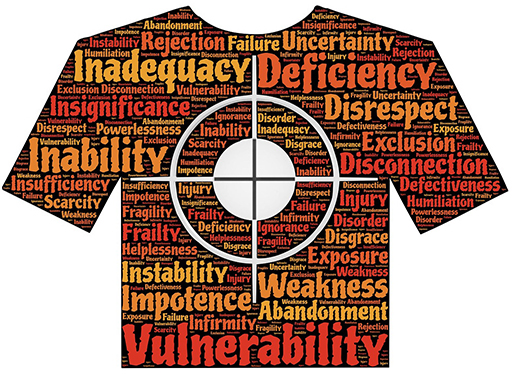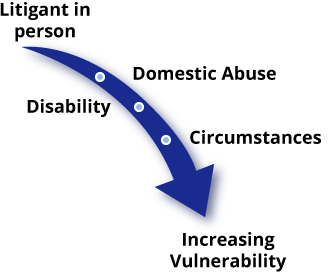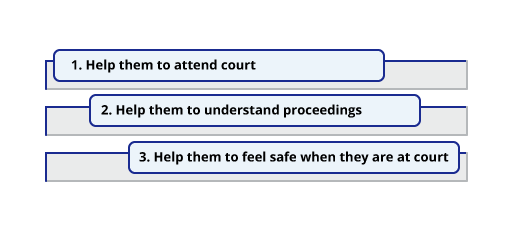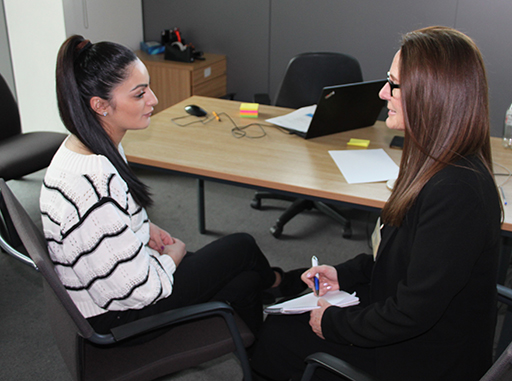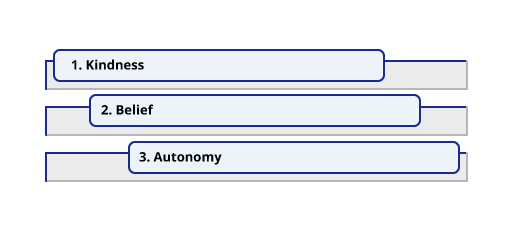Use 'Print preview' to check the number of pages and printer settings.
Print functionality varies between browsers.
Printable page generated Tuesday, 30 April 2024, 6:18 AM
Vulnerability
9.1 Introduction
Welcome to this training module on vulnerability. In your volunteering work you may come across vulnerable people who need extra support when attending court. The court can make various arrangements to assist vulnerable people so they can understand the court process more, be less stressed and attend the court hearings.
Learning outcomes
By the end of this module you will:
- Know what is meant by vulnerability
- Be familiar with what the court can do to support vulnerable people
- Understand how Support Through Court works with vulnerable people.
This module is one of a number of training modules to help Support Through Court volunteers when supporting clients. The modules all use the same case study to explore the different aspects of supporting clients effectively. We will be referring to this example as we work though this module, so it may be helpful to remind yourself of the facts now. You may want to open this case study in a separate window (use Ctrl + click on the link) so you can refer back to it when needed. Find out more about the fictitious Johnson/Smith family and their situation.
During the module you may come across terminology which is unfamiliar to you. Some words are hyperlinked to the Glossary, so by hovering over the word you will be able to see its definition.
Please note
This module deals with some sensitive issues including descriptions of domestic abuse. These training modules are not compulsory, but they are recommended. If you do not feel comfortable to start the module, or if you are affected by the material, or feel you are unable to undergo the training, then Support Through Court can help you. Please speak to your Service Manager when you are next in the office.
If you need immediate support over the phone you can call:
National Domestic Violence Helpline – 0808 200 247
Give your opinion
How would you rate your understanding of vulnerability right now, before you start this module? Submit your answer .
9.2 What is Vulnerability?
Activity 1
There is no single definition of vulnerability that is used in the Family or Civil courts.
Part 3
Please highlight which five of the following characteristics make someone more likely to be vulnerable:
How to use the highlighter
Click on the colour you want to use and then drag your cursor over the text you want to highlight. The return arrow icon erases the single last highlighting you did. If you want to clear all of your highlighting use the Reset button. When you have completed all of your highlighting click on the Save button. To check your answers click on Reveal answer.
9.3 Vulnerability and Unconscious Bias
Activity 2
As you watch this short video clip take a look at the different levels of violence, and at how the onlookers react each time: the video is by MANKIND and is called Violence is Violence. The video raises a number of issues around the gendered nature of domestic abuse. The focus of this section is to look at how we perceive people. To find out more about male victims of domestic abuse please look at the domestic abuse modules which start with the Introduction to domestic abuse module.
Please note that this next video contains strong language and some violence. You are not obliged to watch it if you do not wish to.

Transcript
[STREET NOISES]
[PIGEONS]
[REWINDING]
[STREET NOISE]
Why do you think the onlookers intervened the first time round but not the second?
Comment
The woman protagonist was far more aggressive and violent and yet the onlookers did not intervene – in fact, they thought it was funny. This is almost certainly because the onlookers did not see the man as vulnerable and so did not intervene the second time.
Our unconscious bias makes it hard for us to recognise when someone might be vulnerable. Unconscious bias happens when our brains make incredibly quick judgments and assessments of people and situations without us realising. Often these are based on social stereotypes, which we may not even realise we hold. For example, sometimes the things that appear to make someone strong - status, profession, wealth - might actually make them vulnerable.
At Support Through Court we believe all litigants in person are vulnerable, simply through having to navigate a system designed for professional lawyers. However, there are degrees of vulnerability. In certain circumstances multiple vulnerabilities can make it extremely difficult for an individual to cope with navigating the court process.
The diagram illustrates how multiple characteristics may combine to increase vulnerability.
For example: domestic abuse is a significant factor in a person’s vulnerability and may affect them in a number of ways during the proceedings.
Activity 3
Can you think of a way how experiencing domestic abuse may affect a client, bearing in mind how such a person may be feeling about coming to court?
Comment
For some people, domestic abuse has a magnifying effect on pre-existing vulnerabilities. For example, an already anxious individual who has experienced domestic abuse is likely to be extremely anxious at the thought of facing their abuser in court. For other people, abuse may trigger vulnerabilities such as depression and alcohol dependence.
In these cases the vulnerabilities are often situational and the person finds that their symptoms diminish as they gain distance from the abusive relationship. However, they often return as the relationship is revisited through the court proceedings and the survivor once again comes into contact with their abuser.
Did you know?
It is important to remember that vulnerability may not be constant, consistent or continuous within an individual. Someone who could be regarded as vulnerable at the initial stage of a case might not be vulnerable by the final hearing and vice versa.
Turning to our case study involving the Johnson/Smith family, you may recall that Jazmin Johnson and Steve Smith have separated and are now involved in court proceedings regarding where their child Chloe will live. Click for a reminder about the Johnson/Smith family and their situation.
Activity 4
Would either Steve Smith or Jazmin Johnson be regarded as vulnerable by the courts and if so, why?
Comment
From the information available, Steve is unlikely to be regarded as vulnerable. However, Jazmin Johnson may be vulnerable as her ability to take part in court proceedings may be affected by her being a domestic abuse survivor. She also has a low income, being reliant on benefits and living in emergency accommodation since her separation from Steve.
9.4 Court Support for Vulnerable Individuals
The Court has a duty to consider whether a person’s participation in the proceedings is likely to be diminished by reason of vulnerability and, if so, whether it is necessary to make one or more reasonable adjustments.
Specifically, the court should consider the ability of the party or witness to understand the proceedings, and their role in the court proceedings. This includes being able to put their views to the court, instruct their representative/s before, during and after the hearing and attend the hearing without significant distress.
There are typically three things a court can do to support a vulnerable person.
We will now look at each of these in turn.
Activity 5
The Court can put measures in place to help a vulnerable person feel safe when they are in court. These are sometimes called participation measures or special measures. They may include separate waiting areas, screens in court, using a separate entrance and exit, and even giving evidence remotely. It is always worth checking with the court usher on the day to see what, if any, adjustments have been made. Remember that these reasonable adjustments are at the discretion of the judge. You can find out more by studying our Special measures module.
Activity 6
It is really important that the court is informed about someone’s vulnerability as early as possible in the process. How would you do this?
Comment
Particular vulnerabilities can be identified on the appropriate court application form. Ask your Service Manager about any specific local arrangements that may be in place.
Did you know?
It is important to be thoughtful when dealing with vulnerabilities. It might be that what makes someone vulnerable is extremely personal and they may find it hard to talk about it and to disclose it to the court. These matters will need handling with great sensitivity. You can always ask a fellow volunteer, or your Service Manager, for guidance.
Activity 7
Please complete the following questions. There is one correct answer to each question.
a.
People with a disability are more likely to be vulnerable.
b.
Only women can be vulnerable
c.
Many litigants in person are vulnerable
The correct answer is b.
Answer
The correct answer is only women can be vulnerable. Anyone can be vulnerable for different reasons.
a.
To consider the ability of someone to understand the court proceedings
b.
To consider a person’s occupation
c.
To consider whether the person is the applicant or respondent in the court proceedings
The correct answer is a.
Answer
The correct answer is to consider the ability of someone to understand the court proceedings.
a.
Language barrier
b.
Mental health issues
c.
Being middle aged
d.
Sight/hearing loss
The correct answer is c.
Answer
The correct answer is being middle aged.
a.
A free qualified lawyer
b.
An intermediary
c.
A voluntary support worker
d.
A social worker
The correct answer is b.
Answer
The correct answer is an intermediary.
a.
Tell the court usher
b.
Verbally to the judge
c.
Filling out a relevant court form
d.
By letter to the judge
The correct answer is d.
Answer
The correct answer is by letter to the judge. Letters and emails to judges often fail to reach the judge hearing the case.
9.5 How Support Through Court works with vulnerable Individuals
Support Through Court doesn’t see vulnerability as a bar to participation but rather as requiring additional support to achieve the best possible participation. We don’t make assumptions about what the client needs. We also don’t regard domestic abuse in isolation but as an intrinsic part of the support required by the client.
At Support Through Court we take a Trauma Informed Approach to working with all of our clients, but especially with vulnerable people. This involves working with clients in a way which focuses on giving them kindness, belief and autonomy.
Activity 8
Did you know?
You can find out more about the trauma informed approach to working with clients in our domestic abuse modules, the link to which are in the last section below.
Give your opinion
How would you rate your understanding of vulnerability after completing this module? Submit your answer.
9.6 Your Volunteering with Vulnerable Individuals
This module has explained when an individual may be vulnerable and what the court can do to support them.
In this module you have learned about:
- What is meant by vulnerability
- What the court can do to support vulnerable people
- How Support Through Court works with vulnerable people.
When volunteering with clients who may be vulnerable, please remember:
- Vulnerability is not always visible. Any client can potentially be vulnerable so keep an open mind and be sensitive to any specific needs a client may bring to your attention.
- Remember a volunteer's role is to empower clients to manage their own case, not to remove a client's choice or autonomy.
- Make sure you understand the process for applying for Special measures in your court.
Support Through Court have a suite of training modules which you can complete so please do take a look at the other modules available. You can study these in any order. They include:
- Special measures
- Working with Cafcass
- Interviewing clients
- Writing statements
- Signposting clients to other organisations
- Working with vulnerable people
The domestic abuse modules are designed to be studied in order, from the first to the third. These modules are:
- Introducing domestic abuse
- Supporting survivors of domestic abuse
- Supporting clients who are accused of perpetrating domestic abuse
Give your opinion
Well done, you have completed this module.
How much will it help you with vulnerability in your volunteering? Submit your answer.
9.7 Quiz
This self-assessment quiz contains 5 questions and is a great way to check your understanding of what you have learned in this module on Vulnerability.
The pass mark is 60% and you have unlimited attempts at the quiz. This self-assessment quiz does not count towards your digital badge.
Go to the Vulnerability quiz now.
9.8 Modules 4–9 knowledge assessment
This knowledge assessment contains 10 questions. The pass mark is 80% and you have unlimited attempts at the assessment.
This assessment counts towards your second digital badge which is exclusive to this suite of training modules.
Go to the Modules 4–9 knowledge assessment now and gain your digital badge.
Acknowledgements
Grateful acknowledgement is made to the following sources:
Every effort has been made to contact copyright holders. If any have been inadvertently overlooked the publishers will be pleased to make the necessary arrangements at the first opportunity.
Important: *** against any of the acknowledgements below means that the wording has been dictated by the rights holder/publisher, and cannot be changed.
2686641: 9.2 vulnerability words: Image by John Hain from Pixabay
271467: 9.3 Vulnerable characteristics diagram: Support through court
265347: 9.4 court: Support through court
268693: 9.4 Safety: Nelosa / iStock / Getty Images Plus
270829: 9.5 vulnerable individuals: Steve Topson
Video and Audio
271654: 9.3 Activity 3 MANKIND video: The ManKind Initiative charity (2014) '#ViolenceIsViolence: Domestic abuse advert Mankind' available at https://www.youtube.com/watch?v=u3PgH86OyEM
271653: 9.5 NHS Scotland ‘Trauma Informed Approach’ video: NHS Education for Scotland (2018) 'Opening Doors: Trauma Informed Practice for the Workforce', available at https://vimeo.com/274703693
